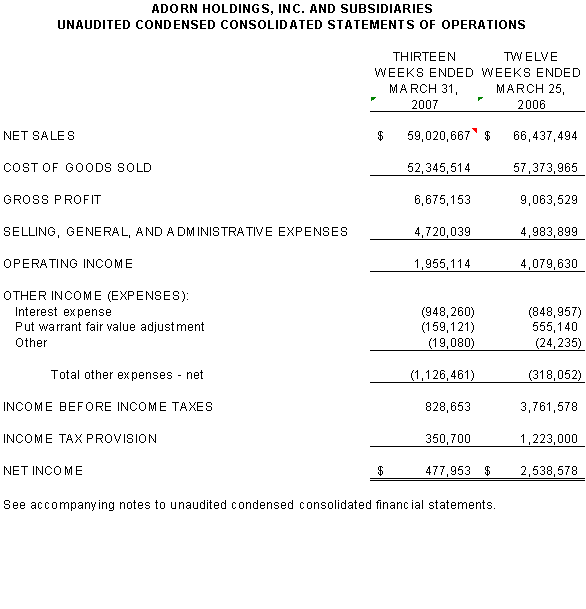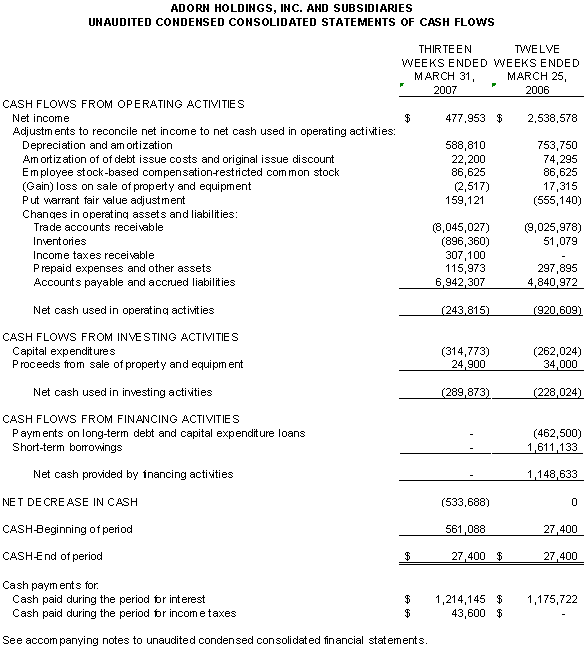UNAUDITED CONDENSED CONSOLIDATED OF ADORN
Published on July 5, 2007
Exhibit 99.2



ADORN HOLDINGS, INC. AND SUBSIDIARIES
NOTES TO UNAUDITED CONDENSED CONSOLIDATED FINANCIAL STATEMENTS
THIRTEEN WEEKS ENDED MARCH 31, 2007 AND TWELVE WEEKS ENDED MARCH 25, 2006
|
1. |
General and Summary of Accounting Policies |
The accompanying unaudited consolidated financial statements have been prepared in accordance with generally accepted accounting principles for interim financial information and Article 10 of Regulation S-X. In the opinion of the management of Adorn Holdings, Inc. (Holdings), and its wholly-owned subsidiary, Adorn, LLC (LLC), (collectively, the Company), the accompanying unaudited condensed consolidated financial statements contain all adjustments (consisting of only normal recurring accruals) necessary to present fairly the financial position of the Company as of March 31, 2007 and the results of its consolidated operations and consolidated cash flows for the thirteen week period ended March 31, 2007 and the twelve week period ended March 25, 2006 in accordance with accounting principles generally accepted in the United States of America (US GAAP).
The Companys interim accounting periods end on the last Saturday of each of the first three quarters. The accompanying financial statements for the periods ended March 31, 2007 and March 25, 2006 include thirteen and twelve weeks of operations, respectively. The Companys annual and fourth quarter accounting periods end on December 31.
Certain information and footnote disclosures normally included with financial statements prepared in accordance with US GAAP have been condensed or omitted. In addition, the balance sheet as of December 31, 2006 has been derived from the audited financial statements as of that date but does not include all of the information and footnotes required by US GAAP for complete financial statements. It is suggested that these condensed consolidated financial statements be read in conjunction with the Companys annual audited consolidated financial statements and notes thereto as of and for the year ended December 31, 2006. The results of operations for the periods ended March 31, 2007 and March 25, 2006 are not necessarily indicative of the results to be expected for the full year.
|
2. |
Inventories |
The inventories of the Company on March 31, 2007 and December 31, 2006 consist of the following classes:

Inventories are stated at the lower of cost (first-in, first-out (FIFO) method) or market.
|
3. |
Income Taxes |
Effective January 1, 2007, the Company adopted the provisions of Financial Accounting Standards Board (FASB) Interpretation No. 48, Accounting for Uncertainty in Income Taxes (FIN No. 48). FIN No. 48 prescribes the minimum accounting and disclosure requirements of uncertain tax positions. Under FIN No. 48, the economic benefit associated with a tax position only will be recognized if it is more likely than not that a tax position ultimately will be sustained.
After this threshold is met, a tax position is reported at the largest amount of benefit that is more likely than not to be ultimately sustained.
The Company operates in several taxing jurisdictions and is subject to examinations by U.S. federal, state and foreign jurisdictions. The Companys income tax positions are based on research and interpretations of the income tax laws and rulings in each of the jurisdictions in which the Company does business. Due to the subjectivity of interpretations of laws and rulings in each jurisdiction, the Companys estimates of income tax liabilities may differ from actual payments or assessments. With few exceptions, the Company is no longer subject to U.S. federal, state or local examinations for years before 2003.
The adoption of FIN No. 48 had no impact on the Companys consolidated financial statements as of January 1, 2007 and for the period ended March 31, 2007. As of March 31, 2007, the Company had no unrecognized income tax benefits.
The Company includes penalties and interest resulting from income tax liabilities in its consolidated income tax provision. No significant penalties or interest were incurred during the periods ended March 31, 2007 or March 25, 2006.
|
4. |
Employee Stock-Based Compensation |
The Company has a stock-based employee compensation plan. Effective January 1, 2006 the Company adopted the provisions of Statement of Financial Accounting Standards (SFAS) No. 123(R), Share-Based Payment, to account for the plan. SFAS No. 123(R) requires compensation expense to be measured under the plan based on the estimated fair values of the awards on the grant dates and recognition of compensation expense over the service period for awards expected to vest. This pronouncement also requires the cash flows from tax benefits resulting from tax deductions in excess of compensation costs recognized for options be classified as financing cash flows in the consolidated statement of cash flows, rather than cash flows from operating activities.
As permitted under SFAS No. 123(R), the Company has continued to account for the awards outstanding at the date of initial application of the pronouncement using the accounting principles originally applied to those awards (the minimum value method under SFAS No. 123, Accounting for Stock-Based Compensation, and its related interpretive guidance). No stock-based compensation awards were issued by the Company in 2006 or during the first quarter of 2007. Employee stock-based compensation expense of $86,625 was recognized by the Company during each of the periods ended March 31, 2007 and March 25, 2006, respectively.
|
5. |
Shareholders Equity |
|
|
The following table summarizes the changes in shareholders equity since December 31, 2006: |

6. Debt Covenants
As of March 31, 2007, the Company was in compliance with the financial covenants included in its credit facility.
|
7. |
New Accounting Pronouncements |
In September 2006, the FASB issued SFAS No. 157, Fair Value Measurements. This statement establishes a framework for measuring fair value and expands disclosures about fair value measurements. This statement does not require any new fair value measurements not previously required under other accounting pronouncements. SFAS No. 157 is effective for fiscal years beginning on or after November 15, 2007. SFAS No. 157 requires adoption prospectively as of the beginning of the fiscal year in which this statement is initially applied, with the exception of certain financial instruments in which adoption must be applied retrospectively as of the beginning of the fiscal year in which the statement is initially applied. The Company is currently in the process of determining the expected impact, if any, of adoption of SFAS No. 157 on its consolidated financial statements.
In February 2007, the FASB issued SFAS No. 159, The Fair Value Option for Financial Assets and Financial Liabilities, which permits entities to choose to measure many eligible financial instruments and certain other items at fair value, with related unrealized gains and losses included in earnings. This pronouncement provides entities the opportunity to mitigate volatility in reported earnings caused by measuring related assets and liabilities differently without having to comply with the complex hedge accounting requirements. SFAS No. 159 is effective for fiscal years beginning on or after November 15, 2007. The Company is not permitted to apply this statement retrospectively to fiscal years preceding the effective date unless it chooses early adoption. The Company is currently in the process of determining the expected impact, if any, of the adoption of SFAS No. 159 on its consolidated financial statements.
|
8. |
Subsequent Event |
On May 18, 2007, Patrick Industries, Inc. acquired all of the outstanding common stock of Holdings in return for a cash payment of $76.7 million (excluding the costs of the transaction), at which time all of the Companys outstanding consolidated indebtedness, put warrants, and stock options were repaid/redeemed from the proceeds of the sale.